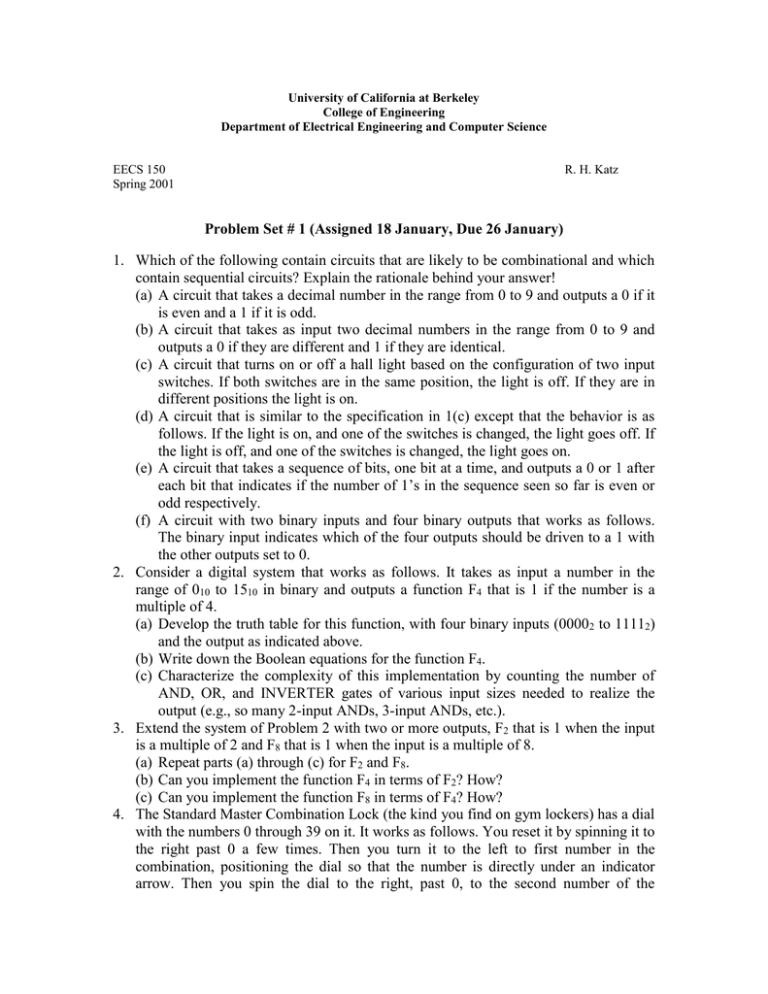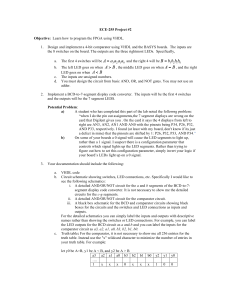University of California at Berkeley College of Engineering
advertisement

University of California at Berkeley College of Engineering Department of Electrical Engineering and Computer Science EECS 150 Spring 2001 R. H. Katz Problem Set # 1 (Assigned 18 January, Due 26 January) 1. Which of the following contain circuits that are likely to be combinational and which contain sequential circuits? Explain the rationale behind your answer! (a) A circuit that takes a decimal number in the range from 0 to 9 and outputs a 0 if it is even and a 1 if it is odd. (b) A circuit that takes as input two decimal numbers in the range from 0 to 9 and outputs a 0 if they are different and 1 if they are identical. (c) A circuit that turns on or off a hall light based on the configuration of two input switches. If both switches are in the same position, the light is off. If they are in different positions the light is on. (d) A circuit that is similar to the specification in 1(c) except that the behavior is as follows. If the light is on, and one of the switches is changed, the light goes off. If the light is off, and one of the switches is changed, the light goes on. (e) A circuit that takes a sequence of bits, one bit at a time, and outputs a 0 or 1 after each bit that indicates if the number of 1’s in the sequence seen so far is even or odd respectively. (f) A circuit with two binary inputs and four binary outputs that works as follows. The binary input indicates which of the four outputs should be driven to a 1 with the other outputs set to 0. 2. Consider a digital system that works as follows. It takes as input a number in the range of 010 to 1510 in binary and outputs a function F4 that is 1 if the number is a multiple of 4. (a) Develop the truth table for this function, with four binary inputs (00002 to 11112) and the output as indicated above. (b) Write down the Boolean equations for the function F4. (c) Characterize the complexity of this implementation by counting the number of AND, OR, and INVERTER gates of various input sizes needed to realize the output (e.g., so many 2-input ANDs, 3-input ANDs, etc.). 3. Extend the system of Problem 2 with two or more outputs, F2 that is 1 when the input is a multiple of 2 and F8 that is 1 when the input is a multiple of 8. (a) Repeat parts (a) through (c) for F2 and F8. (b) Can you implement the function F4 in terms of F2? How? (c) Can you implement the function F8 in terms of F4? How? 4. The Standard Master Combination Lock (the kind you find on gym lockers) has a dial with the numbers 0 through 39 on it. It works as follows. You reset it by spinning it to the right past 0 a few times. Then you turn it to the left to first number in the combination, positioning the dial so that the number is directly under an indicator arrow. Then you spin the dial to the right, past 0, to the second number of the combination. Finally you spin the dial to the left to the last number of the combination. At this point the lock should open. (a) Define the system’s inputs and outputs. (b) Draw a finite state diagram for this subsystem, showing states, transition arcs, and logical conditions under which the machine moves from one state to the next. 5. For the system described in Problem 4, suggest a method for making it possible for the user to program a new combination. (a) What additional inputs do you need to make the lock combination “programmable”? (b) Draw a revised state diagram that shows the state sequencing for programming the lock with a new combination.



![[CH05] Estimasi Usaha dalam Proyek](http://s2.studylib.net/store/data/014618631_1-49924f60adc6d9c12ebc1ef87a169f34-300x300.png)



